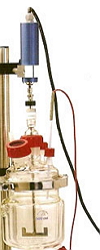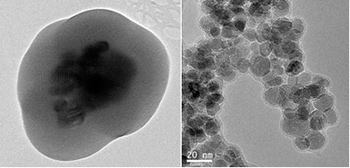ENCAPSULATION OF MAGNETIC AND LUMINISCENT NANOPARTICLES WITH POLYMERIC OR INORGANIC SHELLS
|
Description |

Device that allows synthesis and encapsulation.
In the Group UCM Hybrid Inorganic-Organic Materials we work in the preparation of magnetic and luminescent nanoparticles that present a wide potential of application. Several methods are being tried for their coating with shells of both organic and inorganic nature.
It is known that in recent years the interest in making self-assembled systems has increased because these systems exhibit different properties than simple systems.
Organic polymers offer advantages such as their great flexibility, low density and ease of processing, while the inorganic part provides other characteristics such as surface hardness or high refractive index. The core-shell associations allow the improvement of the mechanical, thermal, magnetic or optical properties and this improvement contributes greatly to the size and shape of the encapsulated inorganic particles together with the distribution and the very constitution of the coating material.
|
How does it work |

Micrographies obtained by TEM of the nanocomposites synthesized in our laboratories, consisting of luminescent nuclei (left) or magnetic nuclei (right).
To obtain the nanocomposites, it has become necessary to develop new preparation methods that involve the control of different reaction parameters. The different tests have allowed a good dispersion of the inorganic nanoparticles in the corresponding matrix, a fundamental requirement for their subsequent application, since it is known that the nanoparticles alone tend to aggregate.
The research group HYBRID INORGANIC ORGANIC MATERIALS has developed reaction processes in which a good dispersion of the nanoparticles is achieved within the inorganic and organic coatings. The encapsulation of the luminescent or magnetic nuclei allows an increase in the useful life of the resulting material, thus reducing its degradation which may be caused by different external factors.
|
Advantages |
The research developed allows the improvement of the chemical, mechanical, thermal, optical or magnetic properties of the inorganic particles, which can be synthesized making them harder, more resistant to heat or less toxic. It should be noted that the encapsulation of the magnetic or luminescent nuclei is carried out with silica and with fully biocompatible polymers.
In addition, the incorporation of different additives into nanocomposites makes it possible to conjugate drugs or their use as luminescent sensors in cell cultures or as heavy metal adsorbent membranes for use in lakes and underground deposits.
|
Where has it been developed |
In the Hybrid Inorganic Organic Materials research group in colaboration with Neuroscience and Aging Foudation. Group members possess great knowledge diversity and for years have worked in different research topics.
|
And also |
The group has the necessary technology to carry out the preparation of solid materials.
In addition, all members of the group have extensive experience in the synthesis of inorganic-organic materials and in the interpretation of properties, being experts in the management of different techniques of structural and morphological characterization.
To date, the encapsulation of magnetic nanoparticles in organic or silica polymers and silicon-based nanoparticles is undergoing several theses within the group Organic Hybrid Inorganic Materials. These theses are aimed at the study of the different applications of nanocomposites in the field of biomedicine and the environment.
|
Contact |
|
© Office for the Transfer of Research Results – UCM |
|
PDF Downloads |
|
Classification |
|
Responsible Researcher |
Josefa Isasi Marín: isasi@quim.ucm.es
Department: Inorganic Chemistry I
Faculty: Chemical Sciences


